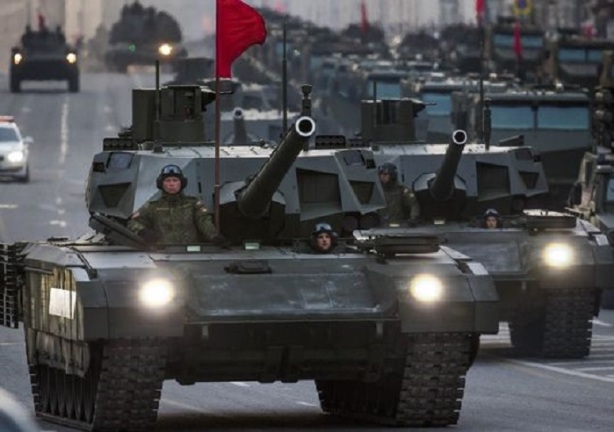For this year’s Victory Day parade, which celebrates its triumph over Nazi Germany some 70 years ago, Russia took the wrap off of its latest armored fighting vehicle, the T-14 Armata tank. According to Army Times, “the new tank will weigh 48 tons and could hit speeds of more than 50 miles per hour, according to a spec sheet released by Russia’s TASS news agency and translated by the U.S. Army’s Foreign Military Studies Office. The three-person tank will be able to fire up to 12 rounds per minute from a 125 mm main gun that can fire multiple types of munitions, including guided missiles, with a range topping out at 8,000 meters.
High-tech highlights include circular-view cameras, a heat sensor and the Afganit active protection complex, which reportedly uses radar to detect incoming threats and destroys them with a rocket.
The T-14’s chassis can support a frame more than 15 tons heavier than what it carries, according to the FMSO. The extra capacity would allow the system to support modified tanks, or serve as the basis of a fleet of vehicles, allowing for a smaller supply chain.
Variants of the Armata could include a 152 mm self-propelled howitzer, a bridge layer, a mine layer, various transport vehicles, even a “launch vehicle in system for heavy rocket propelled flame throwers,” according to the March issue of FMSO’s OE Watch magazine.
A Russian military official said the tank will enter service next year. Within 15 years, more than 2,300 Armatas are set to reach Russian troops.
Sales of the tank to other nations could begin in five years. No potential buyers have been discussed; India makes its own version of Russia’s current T-90 tank under a licensing agreement.”
Despite a slowing economy and drop in oil prices, its interesting that Russia still plans to increase its defense spending relative to its GDP and intends to purchase thousands of main battle tanks over the next few years. Who it perceives as a threat is still anyone’s guess and the west will likely see more saber rattling in the years ahead as it attempts to once again become a superpower. It was this type of strategy that bankrupted the Soviet Union in the late 80s and early 90’s, which led to its collapse and the end of the first Cold War. Accelerated defense spending, the invasion of Ukraine, and chilly international relations could usher in the start of a second Cold War, the expansion of NATO into additional former Warsaw Pact territories, and confrontations in the Arctic region as several nations lay claim to its vast underwater resources. (Composite image shows the T-14 tank on the left and its sister T-15 heavy infantry fighting vehicle on the right)


